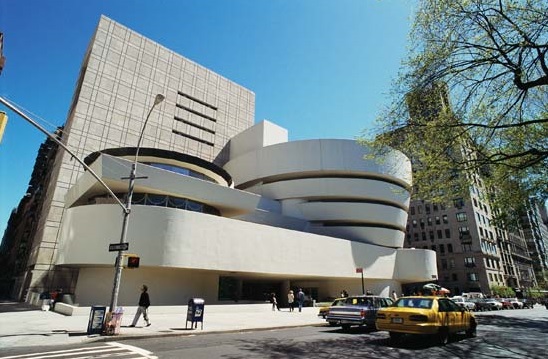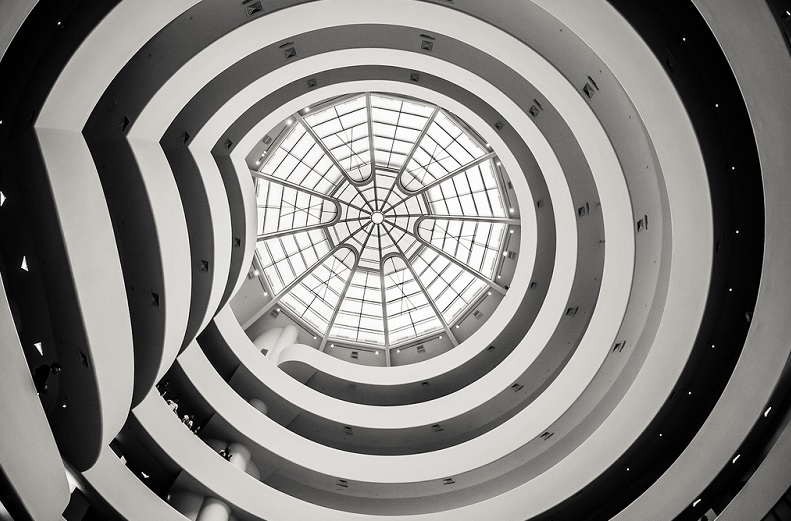Solomon R. Guggenheim Museum
Contents |
[edit] Introduction
The Solomon R. Guggenheim Museum is an art museum located on Fifth Avenue in the Upper East Side neighborhood of Manhattan, New York City. Designed as a distinctive cylindrical form by the architect Frank Lloyd Wright, it is widely acknowledged to be a landmark example of the International Style.
Originally known as the Museum of Non-Objective Painting, the museum was first established by the Solomon R. Guggenheim Foundation in 1939, but in a different location. In the late-1940s, plans were made to move, and Frank Lloyd Wright was commissioned to design a new ‘temple of the spirit’.
It was the only museum Wright designed and would prove to be his final project, as he died six months before its official opening in October 1959. It provoked a mixed response, with some critics calling it ‘the most beautiful building in America’, while others believed the architecture detracted from the art itself, calling it ‘less a museum than a monument to Wright’.
It is now a popular tourist attraction, with around 1.3 million visitors a year.
[edit] Design and construction
Wright was not particularly keen on the idea of designing a building for the ‘overbuilt and overpopulated’ Manhattan. However, after considering several locations he chose the Fifth Avenue site because of its close proximity to Central Park. The urban location meant Wright had to design the building vertically rather than horizontally, in a form that was a departure from the rural works with which he was associated.
He settled on a cylindrical form, with a wider top than base, and the appearance of a white ribbon curled into a stack, in stark contrast to the typically-rectangular buildings that characterised Manhattan.
Wright’s design dispensed with the conventional approach to museum layout. He conceived a continuous helical ramp on a gentle slope that spirals around the outer edges of the building. This allows visitors to view the 92 m-high atrium that rises to an expansive glass dome, while passing several bays of artwork on different levels, creating ‘one great space on a continuous floor’.
In terms of function, a number of artists raised doubts about his design. The shape of the interior walls meant paintings had to be tilted backward, and there were difficulties hanging linear artworks on concave surfaces.
The construction of the building was delayed by World War II, during which, the cost of building materials rose. Construction actually began in 1956 and was completed in 1959.
[edit] Subsequent construction
The museum has been changed a number of times since its completion. There was a major expansion and renovation in 1990-92, when Wright’s original plan for an adjoining sandstone tower was realised. In addition, the atrium skylight, which had been covered, was restored to its original design.
Between 2005 and 2008, the museum underwent exterior restoration to repair cracks and modernise climate-control systems.
[edit] Find out more
[edit] Related articles on Designing Buildings Wiki
Featured articles and news
Editor's broadbrush view on forms of electrical heating in context.
The pace of heating change; BSRIA market intelligence
Electric Dreams, Boiler Realities.
New President of ECA announced
Ruth Devine MBE becomes the 112th President of the Electrical Contractors Association.
New CIAT Professional Standards Competency Framework
Supercedes the 2019 Professional Standards Framework from 1 May 2025.
Difficult Sites: Architecture Against the Odds
Free exhibition at the RIBA Architecture Gallery until 31 May.
PPN 021: Payment Spot Checks in Public Sub-Contracts
Published following consultation and influence from ECA.
Designing Buildings reaches 20,000 articles
We take a look back at some of the stranger contributions.
Lessons learned from other industries.
The Buildings of the Malting Industry. Book review.
Conserving places with climate resilience in mind.
Combating burnout.
The 5 elements of seiri, seiton, seiso, seiketsu and shitsuke.
Shading for housing, a design guide
A look back at embedding a new culture of shading.
The Architectural Technology Awards
The AT Awards 2025 are open for entries!
ECA Blueprint for Electrification
The 'mosaic of interconnected challenges' and how to deliver the UK’s Transition to Clean Power.
Grenfell Tower Principal Contractor Award notice
Tower repair and maintenance contractor announced as demolition contractor.
























